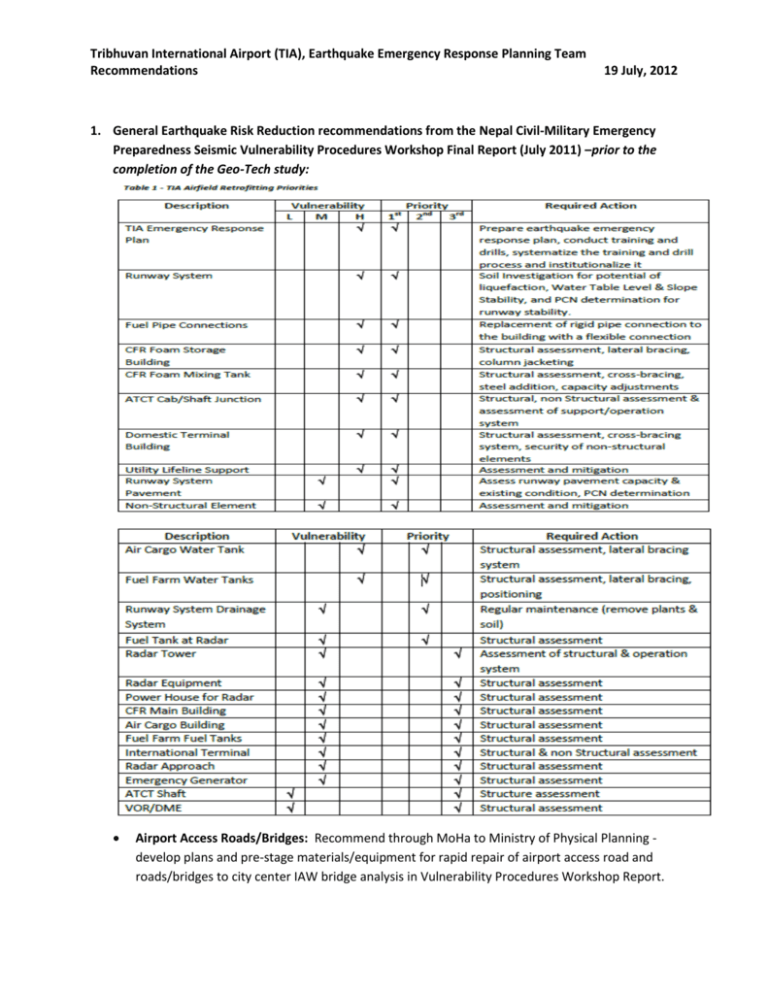Summary of Airport Risk Reduction Recommendations
advertisement

Tribhuvan International Airport (TIA), Earthquake Emergency Response Planning Team Recommendations 19 July, 2012 1. General Earthquake Risk Reduction recommendations from the Nepal Civil-Military Emergency Preparedness Seismic Vulnerability Procedures Workshop Final Report (July 2011) –prior to the completion of the Geo-Tech study: Airport Access Roads/Bridges: Recommend through MoHa to Ministry of Physical Planning develop plans and pre-stage materials/equipment for rapid repair of airport access road and roads/bridges to city center IAW bridge analysis in Vulnerability Procedures Workshop Report. Tribhuvan International Airport (TIA), Earthquake Emergency Response Planning Team Recommendations 19 July, 2012 2. Pavement Report (March 2012) Recommendations: Periodic Maintenance of the Runway system: surface, joints, drainage ditch system, vegetation, water infiltration, etc. Grading and grassing for drainage adjacent to the runway – requires mapping underground cables first. 3. Additional Liquefaction Risk Reduction Recommendations: General recommendations include drainage and relief wells. Specific recommendations are being developed by UBC. 4. Recommendations for Airport Emergency Preparedness: Rapid Runway Repair Kit and Training o Pre-stage materials and heavy equipment for RRR. o Train CAAN personnel, Nepal Army and contractors on repair methods. o Develop list of pre-qualified contractors o Establish warehouse on the airport to stage materials and heavy equipment Space requirements for Humanitarian Staging Areas (HSA), Fuel Operations, Helicopter LZ, A/C Parking and additional Ground Handling Equipment o o Current airport configuration: Grade and compact areas for HAS and provide access road with access to the runway During Airport Improvement Construction: - Identify space during phases of construction over next 4 years - Integrate HSA, warehouse, and slope stabilization into Airport Improvement Plan Communications and NAVAIDS: Assure Radio Transmitter Receiver (RTR) capability – current unit and locate in earthquake proof area of control tower Airport Evacuation Plan: Revise plan with new emergency exits to the land side of airport to support stranded passenger evacuation. Airport Emergency Air Traffic Control: o Pre-determine fixed wing and helicopter traffic patterns for emergency operations o List of priorities for NAVAIDS, Facilities and equipment to maximize emergency air operations/throughput Emergency Communications: Ensure that every organization at the airport has VHF communication with home offices Tribhuvan International Airport (TIA), Earthquake Emergency Response Planning Team Recommendations 19 July, 2012 Training for effective emergency response and restoration o o o o o o o Conduct Airport Earthquake Emergency Exercise – starting with Table Top ex Rapid Visual Assessment training for Civil and Mil Rapid Runway Repair including a drill First Responder training for airport employees Evacuation Drill USAR CSSR Training for Army stationed at the airport Ground Handling equipment training for Army Fuel farm in addition to Seismic Vulnerability Procedures Workshop Final Report: o Ramp up fuel storage to be better prepared to support emergency operations o Address Liquefaction Risk Reduction IAW UBC recommendations o Spill Retention wall - verify the Structural capacity of the wall and install lining Airport Medical Preparedness: Locate emergency medical kits, defibrillators, spinal back – board, cervical collars, oxygen through airport General Airport Preparedness Items: o Identify back up technicians for Technical Services Division o Post schematics for back-up emergency generators and identify and tag incoming and distribution power lines








